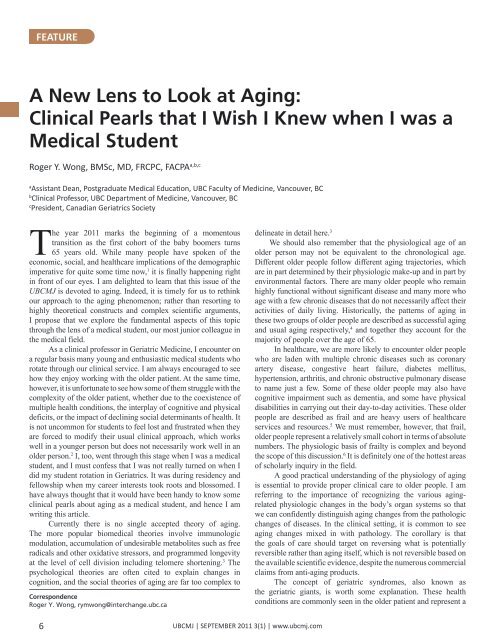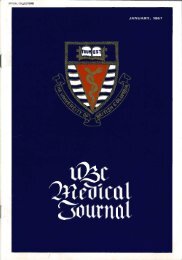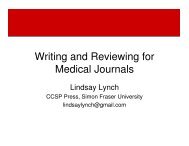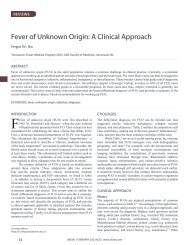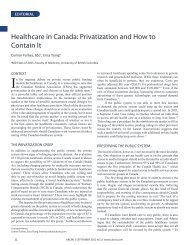Download full PDF - UBC Medical Journal
Download full PDF - UBC Medical Journal
Download full PDF - UBC Medical Journal
You also want an ePaper? Increase the reach of your titles
YUMPU automatically turns print PDFs into web optimized ePapers that Google loves.
FEATURE<br />
A New Lens to Look at Aging:<br />
Clinical Pearls that I Wish I Knew when I was a<br />
<strong>Medical</strong> Student<br />
Roger Y. Wong, BMSc, MD, FRCPC, FACPA a,b,c<br />
a<br />
Assistant Dean, Postgraduate <strong>Medical</strong> Education, <strong>UBC</strong> Faculty of Medicine, Vancouver, BC<br />
b<br />
Clinical Professor, <strong>UBC</strong> Department of Medicine, Vancouver, BC<br />
c<br />
President, Canadian Geriatrics Society<br />
The year 2011 marks the beginning of a momentous<br />
transition as the first cohort of the baby boomers turns<br />
65 years old. While many people have spoken of the<br />
economic, social, and healthcare implications of the demographic<br />
imperative for quite some time now, 1 it is finally happening right<br />
in front of our eyes. I am delighted to learn that this issue of the<br />
<strong>UBC</strong>MJ is devoted to aging. Indeed, it is timely for us to rethink<br />
our approach to the aging phenomenon; rather than resorting to<br />
highly theoretical constructs and complex scientific arguments,<br />
I propose that we explore the fundamental aspects of this topic<br />
through the lens of a medical student, our most junior colleague in<br />
the medical field.<br />
As a clinical professor in Geriatric Medicine, I encounter on<br />
a regular basis many young and enthusiastic medical students who<br />
rotate through our clinical service. I am always encouraged to see<br />
how they enjoy working with the older patient. At the same time,<br />
however, it is unfortunate to see how some of them struggle with the<br />
complexity of the older patient, whether due to the coexistence of<br />
multiple health conditions, the interplay of cognitive and physical<br />
deficits, or the impact of declining social determinants of health. It<br />
is not uncommon for students to feel lost and frustrated when they<br />
are forced to modify their usual clinical approach, which works<br />
well in a younger person but does not necessarily work well in an<br />
older person. 2 I, too, went through this stage when I was a medical<br />
student, and I must confess that I was not really turned on when I<br />
did my student rotation in Geriatrics. It was during residency and<br />
fellowship when my career interests took roots and blossomed. I<br />
have always thought that it would have been handy to know some<br />
clinical pearls about aging as a medical student, and hence I am<br />
writing this article.<br />
Currently there is no single accepted theory of aging.<br />
The more popular biomedical theories involve immunologic<br />
modulation, accumulation of undesirable metabolites such as free<br />
radicals and other oxidative stressors, and programmed longevity<br />
at the level of cell division including telomere shortening. 3 The<br />
psychological theories are often cited to explain changes in<br />
cognition, and the social theories of aging are far too complex to<br />
Correspondence<br />
Roger Y. Wong, rymwong@interchange.ubc.ca<br />
delineate in detail here. 3<br />
We should also remember that the physiological age of an<br />
older person may not be equivalent to the chronological age.<br />
Different older people follow different aging trajectories, which<br />
are in part determined by their physiologic make-up and in part by<br />
environmental factors. There are many older people who remain<br />
highly functional without significant disease and many more who<br />
age with a few chronic diseases that do not necessarily affect their<br />
activities of daily living. Historically, the patterns of aging in<br />
these two groups of older people are described as successful aging<br />
and usual aging respectively, 4 and together they account for the<br />
majority of people over the age of 65.<br />
In healthcare, we are more likely to encounter older people<br />
who are laden with multiple chronic diseases such as coronary<br />
artery disease, congestive heart failure, diabetes mellitus,<br />
hypertension, arthritis, and chronic obstructive pulmonary disease<br />
to name just a few. Some of these older people may also have<br />
cognitive impairment such as dementia, and some have physical<br />
disabilities in carrying out their day-to-day activities. These older<br />
people are described as frail and are heavy users of healthcare<br />
services and resources. 5 We must remember, however, that frail,<br />
older people represent a relatively small cohort in terms of absolute<br />
numbers. The physiologic basis of frailty is complex and beyond<br />
the scope of this discussion. 6 It is definitely one of the hottest areas<br />
of scholarly inquiry in the field.<br />
A good practical understanding of the physiology of aging<br />
is essential to provide proper clinical care to older people. I am<br />
referring to the importance of recognizing the various agingrelated<br />
physiologic changes in the body’s organ systems so that<br />
we can confidently distinguish aging changes from the pathologic<br />
changes of diseases. In the clinical setting, it is common to see<br />
aging changes mixed in with pathology. The corollary is that<br />
the goals of care should target on reversing what is potentially<br />
reversible rather than aging itself, which is not reversible based on<br />
the available scientific evidence, despite the numerous commercial<br />
claims from anti-aging products.<br />
The concept of geriatric syndromes, also known as<br />
the geriatric giants, is worth some explanation. These health<br />
conditions are commonly seen in the older patient and represent a<br />
6<br />
<strong>UBC</strong>MJ | SEPTEMBER 2011 3(1) | www.ubcmj.com


